| the
2005
CanAm CL16 Regatta Hilton Beach, August 6-7 Race 3 photos by Jake Cormier (commentary by Uncle Al) 2005 Regatta Photography is available to purchase! Please view the gallery and note the image names, then contact jake@hiltonbeach.com to order digital versions ($20 each) or professionally printed 8x10s ($35 each, includes postage). ... |
 |
| The fleet is off and
looking good just after the start of Saturday's final
race - a
windward-leeward. ... |
 |
| Most of the boats are
heading for the favoured left side of the course. ... |
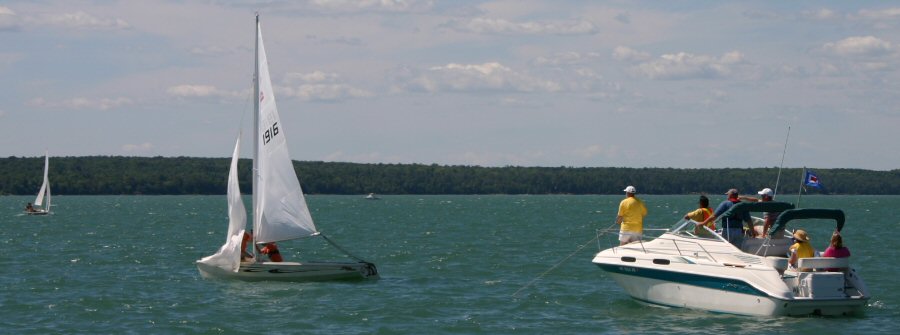 |
|
Glenn Penner and
Ken
Dueck
(1916) are in
the process of jury-rigging a jib halyard after the
previous one - a
totally inadequate 1/16" in diameter - proved unequal
to the task of
dragging Uncle Al's CL out of the best spot on the
start line a few
seconds before the start. When Glenn hooked the end of
his boom over
Al's forestay, the pressure increased on both boats'
systems, and the
weakest link - Glenn's jib halyard - snapped.
... |
 |
| Fortunately for Al (on
run,
2nd from right), the winds were strong and shifty enough
that having
been badly fouled and made to start
in dirty air did not turn out to be an insurmountable
obstacle ... |
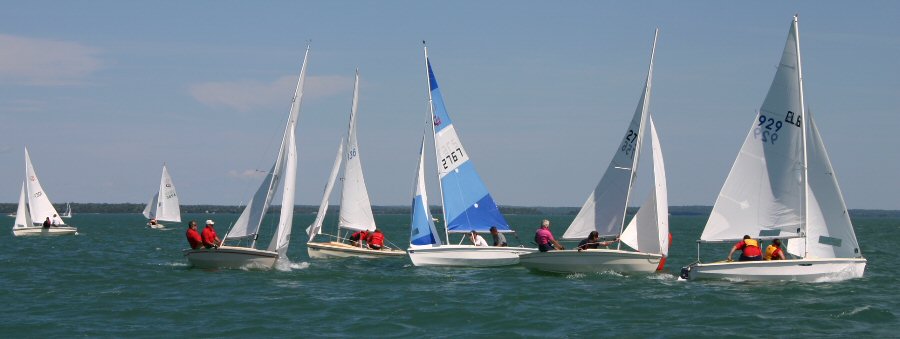 |
|
A nice gust
heats up
the
action at the first windward mark as Colin (929),
Becky (2756) and Eric
(fourth from left) prepare to follow Al (third from
left) onto the run.
In conditions like these, Becky should have Andrew on
the windward
deck to keep the boat flat so that she has less
weather helm to fight
as she tries to bear off onto a run. Here, her crew
has already eased
the jib, and in fact, the very opposite should happen:
the main should
be radically eased as soon as the danger of the boom
hitting the mark
is past, while jib is kept in briefly. Beware though,
that you don't
fall out of the boat and/or lose steering control when
you do this,
because the boat will heel significantly and rapidly
to windward if you
are both hiking. But this windward heel is what you
want since it will
make the boat want to bear away, and you won't slow
down while trying
to get the rudder to do all the work. Meanwhile, John
(2136) and Alfred
(2767) are taking a risky port-tack approach this
close to the mark in
heavy traffic, since rule 18 - see http://www.wayfarer-international.org/WIT/race.related/RacingRulesOfSailing/RulesIndex.html
for more Racing Rules info, and more especially http://www.wayfarer-international.org/WIT/race.related/RacingRulesOfSailing/Rules.in.Pictures/Rules_in_Pics_index.html
for my illustrated explanation of the Rules - places
severe
restrictions on boats tacking within two boatlengths
of the mark.
... |
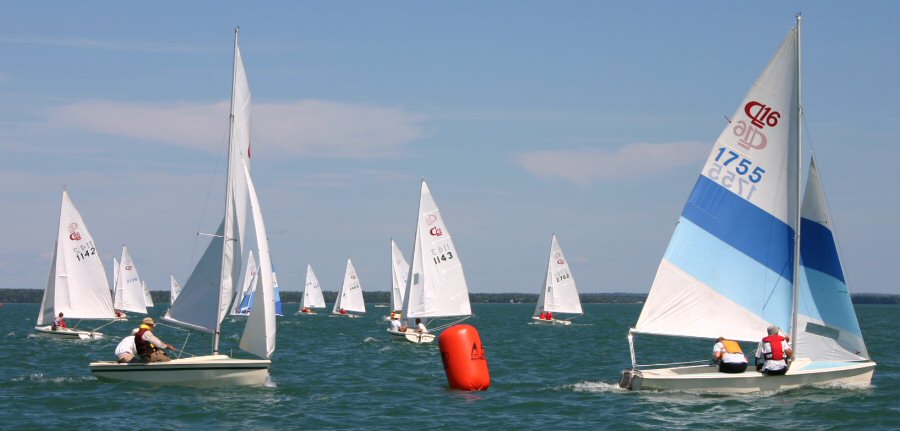 |
|
This would be a
perfect
spot for Conrad (1755) to totally ease his main and
make the turn to a
dead run much easier - note the rudder turbulence!!
Following Conrad, I
think I spy Bill Hibbard crewing on his CL for Charles McLaughlin. Marc and I
specially want to thank
Bill who was most helpful and welcoming as we first
arrived on the
Friday morning!!
... |
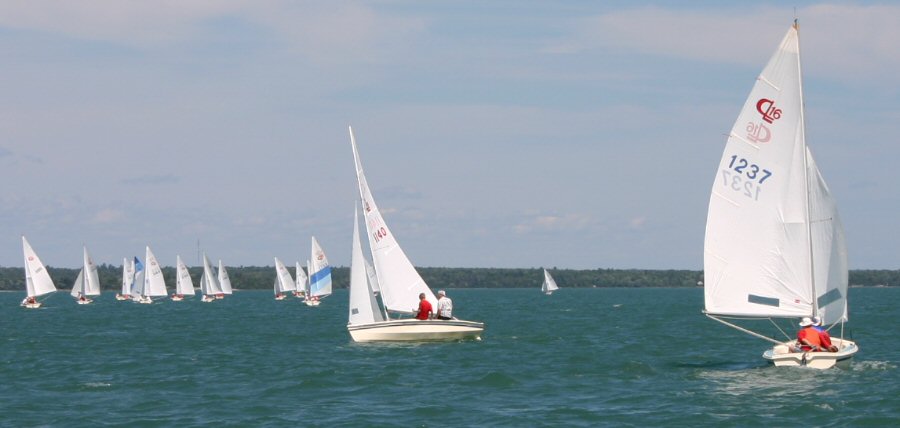 |
|
Note how the
rich are
getting richer here as Uncle Al (2nd from right) can
feel free to sail
a significantly shorter (i.e. straighter) course to
the leeward mark
while the rest of the fleet - almost unavoidably -
works itself well up
to windward of the rhumbline and will sail a big curve
instead of a
straight line. 1140 is Steven and Owen Vail who will
shortly set off in
pursuit
of Bob Tisdall (1237). If the latter had added more
vang tension while
the going was good , i.e. while closehauled, he would
not only project
a bit more sail area going down the run, but also find
the boat easier
to gybe with the main twisted off less. Of course, Bob
would
have to duck a bit more during the gybe since the boom
would sit lower.
... |
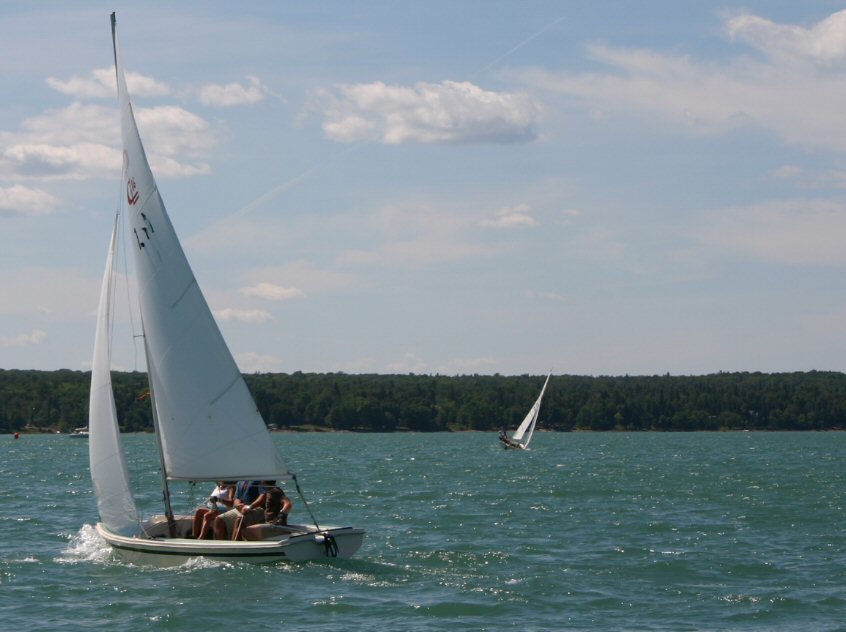 |
|
Heading up the
second
beat
(see windward mark at left), Charles
Marquardt and two strapping crews have no trouble
keeping the boat nice
and flat, and note the minimal wake turbulence as a
result. The extra
weight in the boat will however, cost him pretty
dearly off the wind -
more than he is likely to gain by sailing 3-up on the
beats. Al,
meanwhile, is letting his boat heel and subsequently
round up some
before easing the main and bearing away back to a
normal closehauled
course. Note how, even from this distance, there is no
white water to
be seen coming from the rudder, a sure sign that Al is
not wrestling
with his rudder.
... |
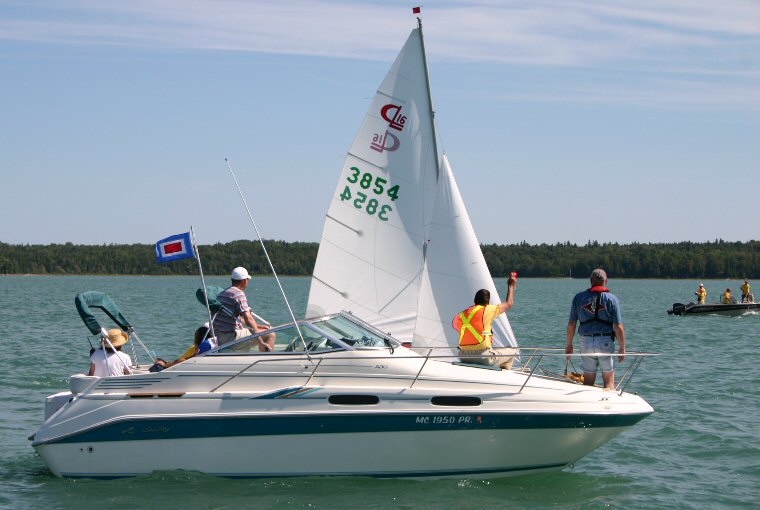 |
| Less than 30 minutes
later
- if the time info that came with Jake's photos is to be
believed, and
it is! - Al and Marc get the first-place beep, crossing
the line in ... ... |
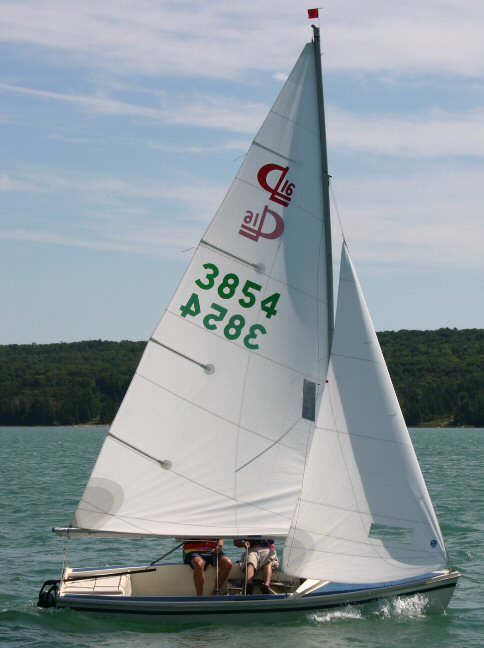 |
|
... perfect form. Note how, when it gets
this windy in the
upwind going, Al sits - as almost always - with his
forward leg against
the thwart, but Marc moves a bit aft from his "up
against the shroud" lighter
air position
until his aft leg is against the thwart to make sure
the bow does not plow when the boat is going this
fast.
Let me tell
you
that we were an extremely happy pair after the
successes we had been
blessed with on this day!! And there was beer and
partying still to
come!! Life just does not get any better than this!
|
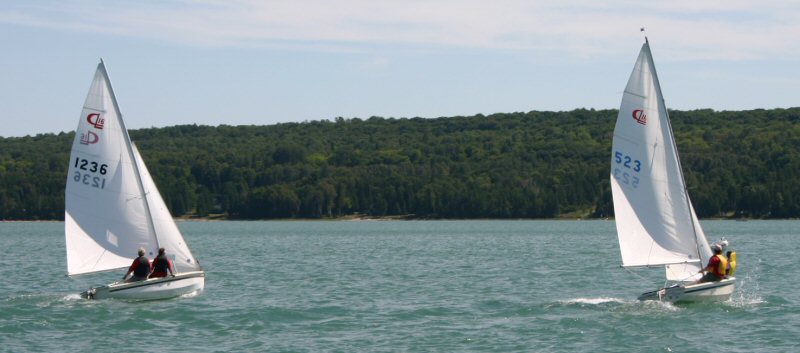 |
| Steve Macklin and son,
Andrew, (523) beat out Jim and Alice Hill for second
place and ended
their day with an excellent 4-2-2. ... |
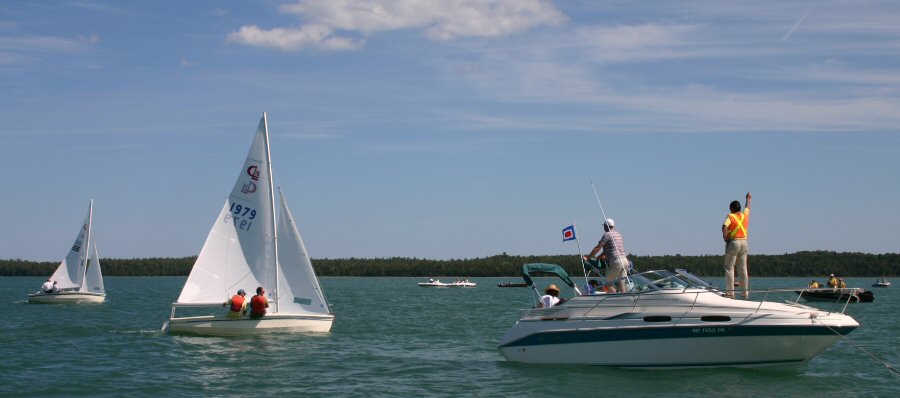 |
| Peter and Jim Foster
(1979)
are about to take 4th - their best finish of the series
- ahead of Kipp
and Ann
Sylvester. ... |
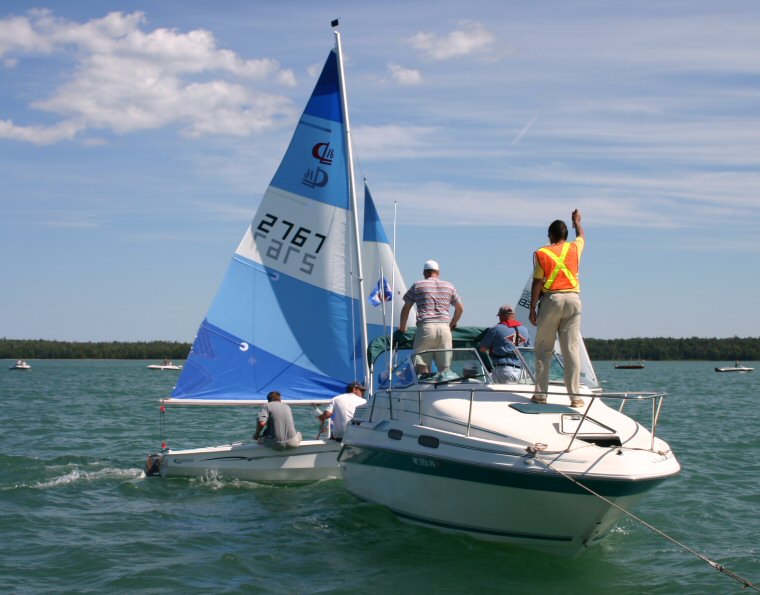 |
| Alfred Gawthrop and
Craig
Bouck end their day on a bright note with ... ... |
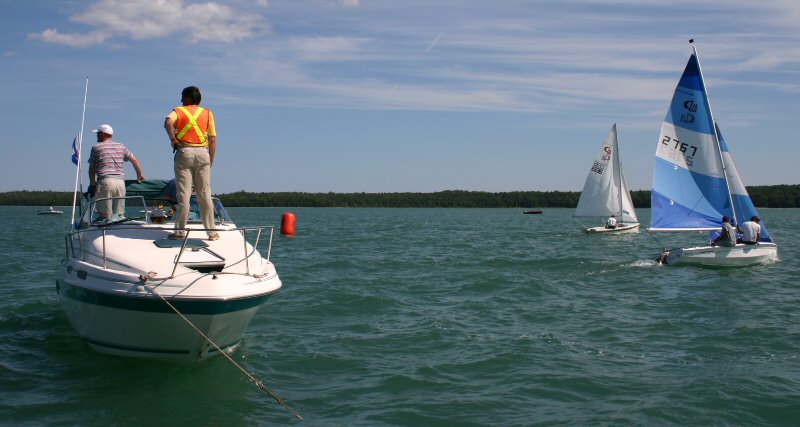 |
| ... a fine 6th just behind Kipp. ... |
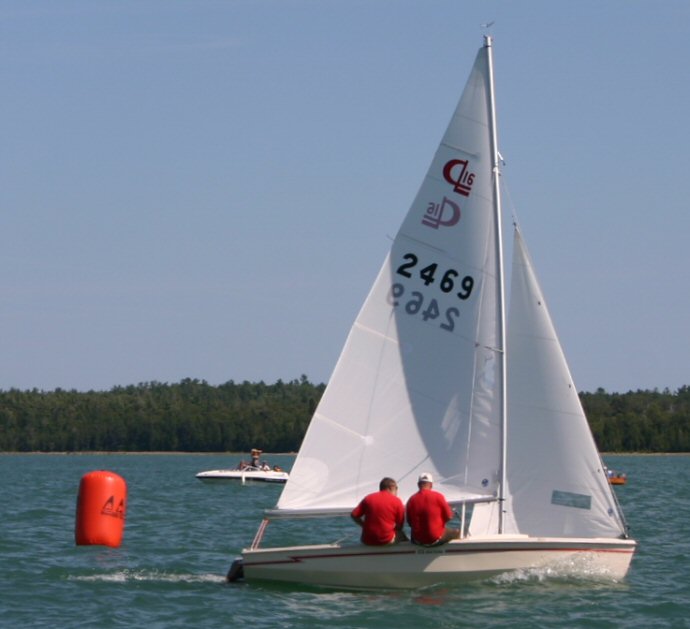 |
| Eric Kirby and Gary
Gjos
look fine as they cross 7th, while ... ... |
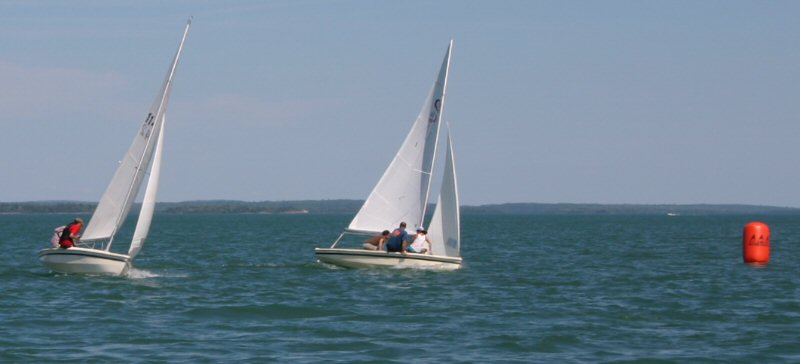 |
|
... Mac and
Nick
Thomas (l) will take a close 8th, just ahead
of the Charles
Marquardt trio who are unlikely to help their speed
any by sitting this
far forward in this strong breeze. Such a strategy
only helps in very
light airs when the boat is going
so slowly that resistance from wetted surface is a
larger factor than
resistance made by the boat pushing the water aside.
|
| return to
index page |